一、C#中MessageBox.Show用法
MessageBox.Show (String) 显示具有指定文本的消息框。 由 .NET Compact Framework 支持。
MessageBox.Show (IWin32Window, String) 在指定对象的前面显示具有指定文本的消息框。
MessageBox.Show (String, String) 显示具有指定文本和标题的消息框。由 .NET Compact Framework 支持。
MessageBox.Show (IWin32Window, String, String) 在指定对象的前面显示具有指定文本和标题的消息框。
MessageBox.Show (String, String, MessageBoxButtons) 显示具有指定文本、标题和按钮的消息框。
MessageBox.Show (IWin32Window, String, String, MessageBoxButtons) 在指定对象的前面显示具有指定文本、标题和按钮的消息框。
MessageBox.Show (String, String, MessageBoxButtons, MessageBoxIcon) 显示具有指定文本、标题、按钮和图标的消息框。
MessageBox.Show (IWin32Window, String, String, MessageBoxButtons, MessageBoxIcon) 在指定对象的前面显示具有指定文本、标题、按钮和图标的消息框。
MessageBox.Show (String, String, MessageBoxButtons, MessageBoxIcon, MessageBoxDefaultButton) 显示具有指定文本、标题、按钮、图标和默认按钮的消息框。 由 .NET Compact Framework 支持。
MessageBox.Show (IWin32Window, String, String, MessageBoxButtons, MessageBoxIcon, MessageBoxDefaultButton) 在指定对象的前面显示具有指定文本、标题、按钮、图标和默认按钮的消息框。
MessageBox.Show (String, String, MessageBoxButtons, MessageBoxIcon, MessageBoxDefaultButton, MessageBoxOptions) 显示具有指定文本、标题、按钮、图标、默认按钮和选项的消息框。
MessageBox.Show (IWin32Window, String, String, MessageBoxButtons, MessageBoxIcon, MessageBoxDefaultButton, MessageBoxOptions) 在指定对象的前面显示具有指定文本、标题、按钮、图标、默认按钮和选项的消息框。
MessageBox.Show (String, String, MessageBoxButtons, MessageBoxIcon, MessageBoxDefaultButton, MessageBoxOptions, Boolean) 显示一个具有指定文本、标题、按钮、图标、默认按钮、选项和"帮助"按钮的消息框。
MessageBox.Show (String, String, MessageBoxButtons, MessageBoxIcon, MessageBoxDefaultButton, MessageBoxOptions, String) 使用指定的帮助文件显示一个具有指定文本、标题、按钮、图标、默认按钮、选项和"帮助"按钮的消息框。
MessageBox.Show (IWin32Window, String, String, MessageBoxButtons, MessageBoxIcon, MessageBoxDefaultButton, MessageBoxOptions, String) 使用指定的帮助文件显示一个具有指定文本、标题、按钮、图标、默认按钮、选项和"帮助"按钮的消息框。
MessageBox.Show (String, String, MessageBoxButtons, MessageBoxIcon, MessageBoxDefaultButton, MessageBoxOptions, String, HelpNavigator) 使用指定的帮助文件和 HelpNavigator 显示一个具有指定文本、标题、按钮、图标、默认按钮、选项和"帮助"按钮的消息框。
MessageBox.Show (String, String, MessageBoxButtons, MessageBoxIcon, MessageBoxDefaultButton, MessageBoxOptions, String, String) 使用指定的帮助文件和帮助关键字[guan jian zi]显示一个具有指定文本、标题、按钮、图标、默认按钮、选项和"帮助"按钮的消息框。
MessageBox.Show (IWin32Window, String, String, MessageBoxButtons, MessageBoxIcon, MessageBoxDefaultButton, MessageBoxOptions, String, HelpNavigator) 使用指定的帮助文件和 HelpNavigator 显示一个具有指定文本、标题、按钮、图标、默认按钮、选项和"帮助"按钮的消息框。
MessageBox.Show (IWin32Window, String, String, MessageBoxButtons, MessageBoxIcon, MessageBoxDefaultButton, MessageBoxOptions, String, String) 使用指定的帮助文件和帮助关键字[guan jian zi]显示一个具有指定文本、标题、按钮、图标、默认按钮、选项和"帮助"按钮的消息框。
MessageBox.Show (String, String, MessageBoxButtons, MessageBoxIcon, MessageBoxDefaultButton, MessageBoxOptions, String, HelpNavigator, Object) 使用指定的帮助文件、HelpNavigator 和帮助主题显示一个具有指定文本、标题、按钮、图标、默认按钮、选项和"帮助"按钮的消息框。
MessageBox.Show (IWin32Window, String, String, MessageBoxButtons, MessageBoxIcon, MessageBoxDefaultButton, MessageBoxOptions, String, HelpNavigator, Object) 使用指定的帮助文件、HelpNavigator 和帮助主题显示一个具有指定文本、标题、按钮、图标、默认按钮、选项和"帮助"按钮的消息框。
用法如:
DialogResult ret =MessageBox.Show( "确定要删除[shan chu]记录么?" , "删除[shan chu]", MessageBoxButtons.OKCancel, MessageBoxIcon.Question);
MessageBox.Show( "提示[ti shi]信息", " 信息标题", MessageBoxButtons.OK);
MessageBox.Show( "提示[ti shi]信息", " 信息标题", MessageBoxButtons.OK, MessageBoxIcon.Error);
我们在程序中经常会用到MessageBox。
MessageBox.Show()共有21中重载[zhong zai]方法。现将其常见用法总结如下:
1. MessageBox .Show( "Hello~~~~" );
最简单的,只显示提示[ti shi]信息。
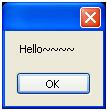
2. MessageBox .Show( "There are something wrong!" , "ERROR" );
可以给消息框加上标[shang biao]题。
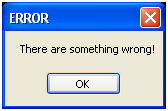
3. if ( MessageBox .Show( "Delete this user?" , "Confirm Message" , MessageBoxButtons .OKCancel) == DialogResult .OK)
{
//delete
}
询问是否删除[shan chu]时会用到这个。
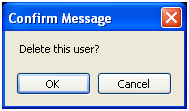
4. if ( MessageBox .Show( "Delete this user?" , "Confirm Message" , MessageBoxButtons .OKCancel, MessageBoxIcon .Question) == DialogResult .OK)
{
//delete
}
可以给MessageBox加上一个Icon,.net提供常见的Icon共选择[xuan ze]。
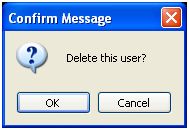
5. if ( MessageBox .Show( "Delete this user?" , "Confirm Message" , MessageBoxButtons .OKCancel, MessageBoxIcon .Question, MessageBoxDefaultButton .Button2) == DialogResult .OK)
{
//delete
}
可以改变MessageBox的默认焦点,如下:
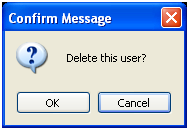
6. if ( MessageBox .Show( "Delete this user?" , "Confirm Message" , MessageBoxButtons .OKCancel, MessageBoxIcon .Question, MessageBoxDefaultButton .Button2, MessageBoxOptions .RtlReading) == DialogResult .OK)
{
//delete
}
反向显示:
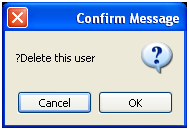
7. if ( MessageBox .Show( "Delete this user?" , "Confirm Message" , MessageBoxButtons .OKCancel, MessageBoxIcon .Question, MessageBoxDefaultButton .Button2, MessageBoxOptions .RightAlign, true ) == DialogResult .OK)
{
//delete
}
添加Help按钮:
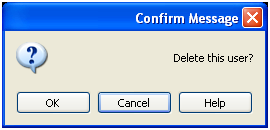
8. if ( MessageBox .Show( "Delete this user?" , "Confirm Message" , MessageBoxButtons .OKCancel, MessageBoxIcon .Question, MessageBoxDefaultButton .Button1, MessageBoxOptions .RtlReading, @"/folder/file.htm" ) == DialogResult .OK)
{
//delete
}
指定帮助文件的路径[lu jing],点击即可打开该路径[lu jing]下的帮助文件。

9. //HelpNavigator 指定常数来指示[zhi shi]要显示的帮助文件元素。 Find 帮助文件将打开到搜索[sou suo]页。
if ( MessageBox .Show( "Delete this user?" , "Confirm Message" , MessageBoxButtons .OKCancel, MessageBoxIcon .Question, MessageBoxDefaultButton .Button1, MessageBoxOptions .RtlReading, @"/folder/file.htm" , HelpNavigator .Find) == DialogResult .OK)
{
//delete
}
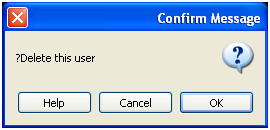
还有一些用法,不是太实用这里就不一一介绍了,有兴趣的朋友可以参考下这里: MSDN 的MessageBox类。
二、VB.NET中MsgBox用法
MsgBox: Prompts a dialog box that displays a message.
Examples:
MsgBox ("Thank You for the Help!")
Information from the MSDN: MsgBox Function
Parameters
-
Prompt
- Required. String expression displayed as the message in the dialog box. The maximum length of Prompt is approximately 1024 characters, depending on the width of the characters used. If Prompt consists of more than one line, you can separate the lines using a carriage return character ( Chr(13 )), a linefeed character ( Chr(10 )), or a carriage return/linefeed character combination ( Chr(13 ) & Chr(10 )) between each line. Buttons
- Optional. Numeric expression that is the sum of values specifying the number and type of buttons to display, the icon style to use, the identity of the default button, and the modality of the message box. If you omit Buttons, the default value is zero. Title
- Optional. String expression displayed in the title bar of the dialog box. If you omit Title, the application name is placed in the title bar.
Settings
The MsgBoxStyle enumeration values are listed in the following table.
| Enumeration | Value | Description |
|---|---|---|
| OKOnly |
0
| Displays OK button only. |
| OKCancel |
1
| Displays OK and Cancel buttons. |
| AbortRetryIgnore |
2
| Displays Abort, Retry, and Ignore buttons. |
| YesNoCancel |
3
| Displays Yes, No, and Cancel buttons. |
| YesNo |
4
| Displays Yes and No buttons. |
| RetryCancel |
5
| Displays Retry and Cancel buttons. |
| Critical |
16
| Displays Critical Message icon. |
| Question |
32
| Displays Warning Query icon. |
| Exclamation |
48
| Displays Warning Message icon. |
| Information |
64
| Displays Information Message icon. |
| DefaultButton1 |
0
| First button is default. |
| DefaultButton2 |
256
| Second button is default. |
| DefaultButton3 |
512
| Third button is default. |
| ApplicationModal |
0
| Application is modal. The user must respond to the message box before continuing work in the current application. |
| SystemModal |
4096
| System is modal. All applications are suspended until the user responds to the message box. |
| MsgBoxSetForeground |
65536
| Specifies the message box window as the foreground window. |
| MsgBoxRight |
524288
| Text is right-aligned. |
| MsgBoxRtlReading |
1048576
| Specifies text should appear as right-to-left reading on Hebrew and Arabic systems. |
The first group of values (0–5) describes the number and type of buttons displayed in the dialog box; the second group (16, 32, 48, 64) describes the icon style; the third group (0, 256, 512) determines which button is the default; the fourth group (0, 4096) determines the modality of the message box, and the fifth group specifies whether or not the message box window is the foreground window, along with the alignment and direction of the text. When adding numbers to create a final value for the Buttons argument, use only one number from each group.
Return Values
|
Constant
|
Value
|
|---|---|
|
OK
|
1
|
|
Cancel
|
2
|
|
Abort
|
3
|
|
Retry
|
4
|
|
Ignore
|
5
|
|
Yes
|
6
|
|
No
|
7
|
Exceptions/Errors
|
Exception type
| Error number | Condition |
|---|---|---|
|
ArgumentException
|
5
| Prompt is not a String expression, or Titleis invalid. |
|
InvalidOperationException
|
5
| Process is not running in User Interactive mode. |
|
InvalidEnumArgumentException
|
5
| One or more parameters not a member ofMsgBoxResult or MsgBoxStyleenumerations. |
Remarks
If the dialog box displays a Cancel button, pressing the ESC key has the same effect as clicking Cancel. If the dialog box contains a Help button, context-sensitive Help is provided for the dialog box. However, no value is returned until one of the other buttons is clicked.
Note To specify more than the first argument, you must use the MsgBox function in an expression. If you omit any positional arguments, you must retain the corresponding comma delimiter.
Example
This example uses the MsgBox function to display a critical-error message in a dialog box with Yes and No buttons. The No button is specified as the default response. This is done by combining the MsgBox constant values into one numeric expression. In this case, adding 4 (the Yes/No button combination) and 16 (the Critical Message window) and 256 (the second button as default button) gives a total of 276. The value returned by the MsgBox function depends on the button chosen by the user: Yes returns a value of 6; No returns a value of 7.
Dim msg As String Dim title As String Dim style As MsgBoxStyle Dim response As MsgBoxResult msg = "Do you want to continue?" ' Define message. style = MsgBoxStyle.DefaultButton2 Or _ MsgBoxStyle.Critical Or MsgBoxStyle.YesNo title = "MsgBox Demonstration" ' Define title. ' Display message. response =MsgBox(msg, style, title)' or MsgBox(msg, MsgBoxStyle.YesNo, title) If response = MsgBoxResult.Yes Then ' User chose Yes. ' Perform some action. Else ' Perform some other action. End If
原文出处
链接①:http://blog.csdn.net/fan158/article/details/5891780
链接②:http://www.lob.cn/jq/kfjq/570.shtml




















 1031
1031











 被折叠的 条评论
为什么被折叠?
被折叠的 条评论
为什么被折叠?








